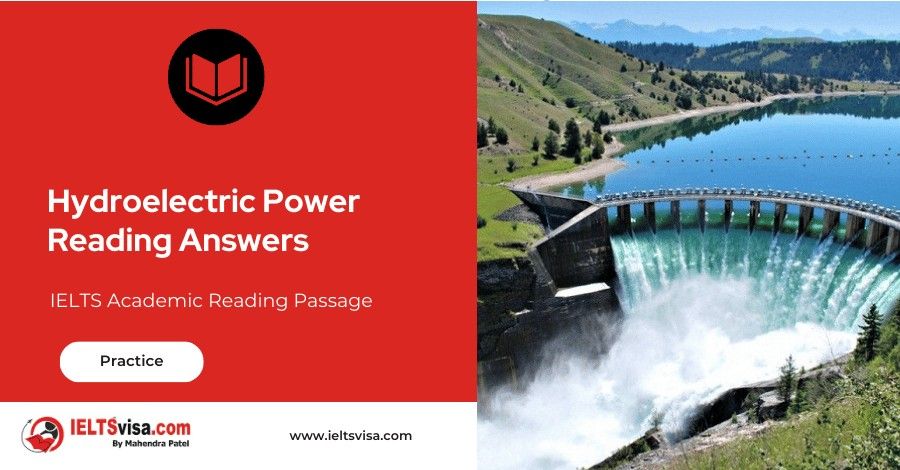Hydroelectric Power Reading Answers
IELTS Academic Reading Passage
A. Hydroelectric power is America’s leading renewable energy resource. Of all the renewable power sources, it’s the most reliable, efficient, and economical. Water is needed to run a hydroelectric generating unit. It’s held in a reservoir or lake behind a dam, and the force of the water being released from the reservoir through the dam spins the blades of a turbine. The turbine is connected to the generator that produces electricity. After passing through the turbine, the water re-enters the river on the downstream side of the dam.
B. Hydroelectric plants convert the kinetic energy within falling water into electricity. The energy in moving water is produced in the sun, and consequently is continually being renewed. The energy in sunlight evaporates water from the seas and deposits it on land as rain. Land elevation differences result in rainfall runoff, and permit some of the original solar energy to be harnessed as hydroelectric power. Hydroelectric power is at present the earth’s chief renewable electricity source, generating 6% of global energy and about 15% of worldwide electricity.
C. Hydroelectric power in Canada is plentiful and provides 60% of their electrical requirements. Usually regarded as an inexpensive and clean source of electricity, most big hydroelectric projects being planned today are facing a great deal of hostility from environmental groups and local people.
D. The earliest recorded use of water power was a clock, constructed around 250 BC. Since then, people have used falling water to supply power for grain and saw mills, as well as a host of other uses. The earliest use of flowing water to generate electricity was a waterwheel on the Fox River in Wisconsin in 1882.
E. The first hydroelectric power plants were much more dependable and efficient than the plants of the day that were fired by fossil fuels. This led to a rise in the number of small to medium sized hydroelectric generating plants located wherever there was an adequate supply of falling water and a need for electricity. As demand for electricity soared in the middle years of the 20th century, and the effectiveness of coal and oil power plants improved, small hydro plants became less popular. The majority of new hydroelectric developments were focused on giant mega- projects.
F. Hydroelectric plants harness energy by passing flowing water through a turbine. The water turbine rotation is delivered to a generator, which generates electricity. The quantity of electricity that can be produced at a hydroelectric plant relies upon two variables. These variables are (1) the vertical distance that the water falls, called the “head”, and (2) the flow rate, calculated as volume over time. The amount of electricity that is produced is thus proportional to the head product and the flow rate.
G. So, hydroelectric power stations can normally be separated into two kinds. The most widespread are “high head” plants and usually employ a dam to stock up water at an increased height. They also store water at times of rain and discharge it during dry times. This results in reliable and consistent electricity generation, capable of meeting demand since flow can be rapidly altered. At times of excess electrical system capacity, usually available at night, these plants can also pump water from one reservoir to another at a greater height. When there is peak electrical demand, the higher reservoir releases water through the turbines to the lower reservoir.
H. “Low head” hydroelectric plants usually exploit heads of just a few metres or less. These types of power stations use a weir or low dam to channel water, or no dam at all and merely use the river flow. Unfortunately, their electricity production capacity fluctuates with seasonal water flow in a river.
I. Until only recently people believed almost universally that hydroelectric power was an environmentally safe and clean means of generating electricity. Hydroelectric stations do not release any of the usual atmospheric pollutants emitted by power plants fuelled by fossil fuels so they do not add to global warming or acid rain. Nevertheless, recent studies of the larger reservoirs formed behind dams have implied that decomposing, flooded vegetation could give off greenhouse gasses equal to those from other electricity sources.
J. The clearest result of hydroelectric dams is the flooding of huge areas of land. The reservoirs built can be exceptionally big and they have often flooded the lands of indigenous peoples and destroyed their way of life. Numerous rare ecosystems are also endangered by hydroelectric power plant development.
K. Damming rivers may also change the quantity and quality of water in the rivers below the dams, as well as stopping fish migrating upstream to spawn. In addition, silt, usually taken downstream to the lower parts of a river, is caught by a dam and so the river downstream loses the silt that should fertilise the river’s flood plains during high water periods.
L. Theoretical global hydroelectric power is approximately four times larger than the amount that has been taken advantage of today. Most of the residual hydro potential left in the world can be found in African and Asian developing countries. Exploiting this resource would involve an investment of billions of dollars, since hydroelectric plants normally have very high building costs. Low head hydro capacity facilities on small scales will probably increase in the future as low head turbine research, and the standardisation of turbine production, reduce the costs of low head hydro-electric power production. New systems of control and improvements in turbines could lead in the future to more electricity created from present facilities. In addition, in the 1950’s and 60’s when oil and coal prices were very low, lots of smaller hydroelectric plants were closed down. Future increases in the prices of fuel could lead to these places being renovated.
Questions 28–32
Read the passage again and look at the statements below. In boxes 28 – 32 on your answer sheet write:
TRUE if the statement is true
FALSE if the statement is false
NOT GIVEN if the information is not given in the passage.
28. Canada uses the most hydroelectric power in the world today.
29. Early use of hydroelectric power was in the timber industry.
30. The first hydroelectric power stations were more effective than those using competing energy sources.
31. People have been drowned by the flooding of their traditional territory when reservoirs are created.
32. Nowadays, agriculture below hydroelectric dams is not affected by the change in water flow.
Questions 33–36
Complete each of the following statements (Questions 06 – 09) with words taken from the Reading Passage.
Write NO MORE THAN THREE WORDS for each answer.
Write your answers in boxes 33 – 36 on your answer sheet.
The origin of hydroelectric power is the 33. __________ produced when water obeys the laws of gravity.
How far water drops to the turbines in a power station is known as 34.__________
A drawback to the low head hydroelectric power stations is that they depend on 35.__________.
Derelict hydroelectric power stations could be 36. __________ in the future.
Questions 37 – 40
Using NO MORE THAN THREE WORDS from the Reading Passage, answer the following questions.
Write your answers in boxes 37– 40 on your answer sheet.
37. What proportion of the world’s electricity supply is provided by hydroelectric power?
38. How is the flow rate of a hydroelectric power station quantified?
39. When do high head power plants use surplus electricity to transfer water to a second reservoir?
40. What underwater action can lead to the production of pollution similar to that produced by fossil fuel power stations?

Solution For: Hydroelectric Power
Reading Answers
| 28 – NOT GIVEN | 35 – Seasonal water flow |
| 29 – TRUE | 36 – renovated |
| 30 – TRUE | 37 – 15% |
| 31 – NOT GIVEN | 38 – Volume over time |
| 32 – FALSE | 39 – At night |
| 33 – Kinetic energy | 40 – Decomposing flooded vegetation |
| 34 – The head |
Review and Practice
- Regularly practice with IELTS reading samples and time yourself to get used to the pressure of the exam.
- Review your mistakes to understand where you went wrong and how to avoid similar errors in the future.
Our Books
Master IELTS Speaking Part 1
IELTS Writing Task 1 Book
IELTS Writing Task 2 Book
Hydroelectric Power Reading Answers Explanation
Comin Soon
Practice IELTS Other Modules
IELTS Listening
The IELTS Listening test assesses how well you can understand spoken English in various contexts. It lasts about 30 minutes and is divided into four sections with a total of 40 questions. The listening tasks become increasingly difficult as the test progresses.
IELTS Academic Reading
The IELTS Academic Reading section assesses your ability to understand and interpret a variety of texts in academic settings. It is designed to evaluate a range of reading skills, including skimming for gist, reading for main ideas, reading for detail, understanding inferences, and recognizing a writer's opinions and arguments.
IELTS Speaking
The IELTS Speaking test assesses your ability to communicate in English on everyday topics. It lasts 11-14 minutes and consists of three parts: introduction, cue card, and a discussion based on the cue card topic.
IELTS General Reading
IELTS General Reading tests your ability to understand and interpret various types of texts. Here are some key areas and types of content you can expect to encounter in the reading section, along with tips for effective preparation.
IELTS Academic Writing Task 1
In IELTS Academic Writing Task 1, you are presented with a visual representation of information, such as graphs, charts, tables, or diagrams, and you are required to summarize, compare, or explain the data in your own words.
IELTS General Writing Task 1
In IELTS General Writing Task 1, you are required to write a letter based on a given situation. The letter can be formal, semi-formal, or informal, depending on the prompt. Here’s a breakdown of the key components to include in your letter
IELTS Academic Writing Task 2
In IELTS Academic Writing Task 2, you are required to write an essay in response to a question or topic. Here’s a guide to help you understand the essential elements of this task
IELTS Exam Tips
To succeed in the IELTS exam, practice regularly, familiarize yourself with the test format, improve your vocabulary, develop time management skills, and take mock tests to build confidence.
Grammer for IELTS
Grammar is the foundation of effective communication in English. Understanding tense usage, subject-verb agreement, and sentence structure enhances clarity and coherence in writing and speaking.
Vocabulary for IELTS
Vocabulary plays a crucial role in the IELTS (International English Language Testing System) exam, especially in the Speaking and Writing sections. Here’s an overview of why vocabulary is important and how it impacts your performance
RECENT IELTS SAMPLES QUESTIONS AND ANSWERS
Ebonics Reading Answers
A. Ebonics - also known by a host of other names such as African American Vernacular English,...
A Disaster Of Titanic Proportions
A. At 11:39 p.m. on the evening of Sunday, 14 April 1912, lookouts Frederick Fleet and...
Vitamins To supplement or not?
Mineral, vitamin, and antioxidant health supplements make up a multi-billion-dollar industry...
The Hollywood film industry
A. This chapter examines the ‘Golden Age’ of the Hollywood film studio system and explores how...
Three Dimensional Films Reading Answers
A. In the theatre of the Ambassador Hotel in Los Angeles, on the evening of 27 September 1922,...
The Developing World Reading Answers
A THE DEVELOPING WORLD — the economically underdeveloped countries of Asia. Africa. Oceania...













